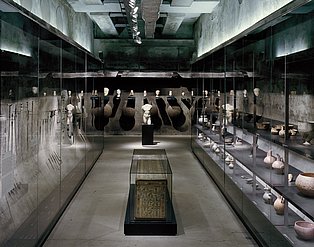
The archaeological collection, whose foundation goes back to the “Historischer Verein von Stadt und Stift Essen” (Historical Society of the City and Abbey of Essen) founded in 1880, comprises more than 50.000 objects from different periods, cultures and materials. The largest addition to the collection was made by Dr. Ernst Kahrs, director of the Ruhrlandmuseum between 1910 and 1948, who succeeded in expanding the prehistoric focus of the collection to include objects from Northern and Central Europe as well as Egypt through extensive excavations in North Rhine-Westphalia and various purchases, including from the archaeologist Robert Forrer. Particularly noteworthy are the excellently preserved finds of organic materials from the Neolithic and Bronze Age pile-dwelling settlements of the European Alpine foothills.
Subsequent acquisitions, especially after the Second World War, concentrated mainly on objects from the so-called advanced civilisations of Greece, Italy, Iran, Iraq, Syria and Egypt. These acquisitions resulted in magnificent collections of ancient Greek and Roman vessels and glass as well as Luristan bronzes from Iran.
Essen's urban archaeology, whose excavation finds range from the Palaeolithic to the early modern period and, more recently, to industrial history, is constantly expanding and enriching the Ruhr Museum's local and regional archaeological holdings.
Part of the Archaeological Collection can be seen in the Ruhr Museum's Permanent Exhibition.
Large parts of the Archaeological Collection can now be seen in the Schaudepot as part of a guided tour.